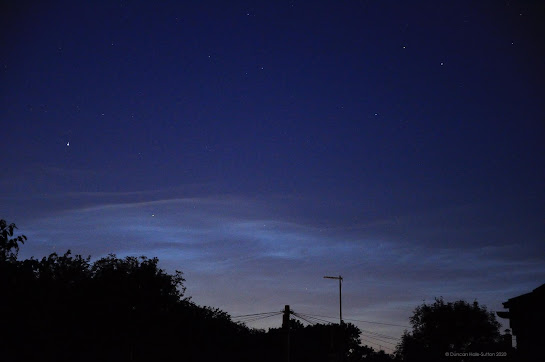On the 18th March this year a new nova was discovered in Cassiopeia by Yuji Nakamura of Japan and was given a designation of V1405 Cas. It was found to be about 1/2 degree south of the open cluster M52 and about 1/2 degree east of the Bubble Nebula (NGC7635). I have been meaning to get around to photographing this 'new star' since I heard the news. Within a few days of its discovery it had brightened from visual magnitude 9.6 to about 8.0 and for about 7 weeks it stayed roughly at that brightness. Then around the 6th May it began to brighten again and it reached a peak of about magnitude 5.3 on the 11th.
This image was taken on the 16th May at about 23.30 BST. I used a Nikon D90 with a 18-105mm lens at 58mm. The exposure time was 15s at ISO 1600. I have adjusted the exposure compensation by +1.0 and binned the image x2. You can click on this image to see a larger view. I have marked the position of the nova.
By the time this image was taken its brightness had dropped from its peak to about 6.6 and since then has continued fall to about 8th magnitude. You can look at a light curve for this object by going to the AAVSO website and typing in V1405 Cas in the text box where its says plot a light curve.
So what is a nova? From an observer's perspective, a nova is the sudden appearance of what looks like a new star where previously there was none to be seen. In actual fact, what we are seeing is a sudden burst of light emitted from a binary star system that was much fainter than was observable. In a classic nova, which I think this is, one of the binary star members is a white dwarf and the other is a main sequence star like our own sun or an evolved star. The orbits of these two stars about their common centre of gravity is very close and tidal forces pull material from the outer layers of the main sequence star into an accretion disc around the white dwarf. A white dwarf is the stellar remnant of a main sequence star and as such, it is compact and very dense. Hydrogen and helium from the accretion disc eventually makes its way to the surface of the white dwarf and when enough of this material collects, a chain reaction of nuclear fusion occurs and the material literally explodes like an H-bomb. The white dwarf suddenly increases in brightness by 50,000 to 100,000 times and ejects material at very fast velocities.
All text and images © Duncan Hale-Sutton 2021









